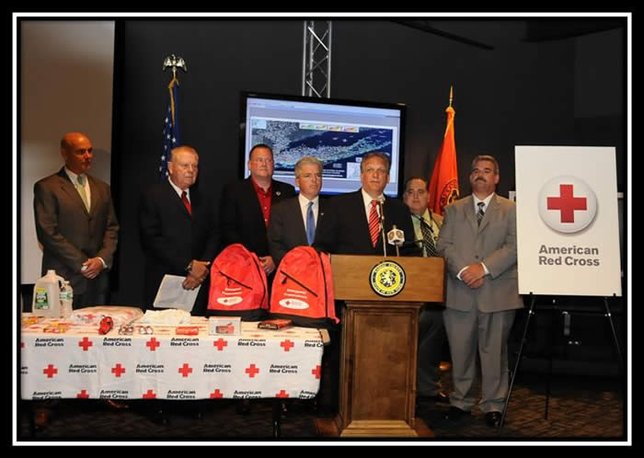Nassau County, NY - May 30, 2014 - With the 2014 Atlantic Hurricane Season beginning June 1st, Nassau County Executive Edward P. Mangano, Suffolk County Executive Steve Bellone and the American Red Cross urge all residents to update or develop their Family Emergency Plan, Emergency Go-Kit and Family & Friends Sheltering Plan.
“Superstorm Sandy taught us that given our location as an island, we are vulnerable to the Atlantic Ocean and susceptible to the powerful and destructive nature of hurricanes,” said County Executive Mangano. “It is critical that residents be prepared for hurricane season and take all hurricane warnings seriously. Don’t take any chances and make sure you Emergency Go-Kit and Family & Friends Sheltering Plan are in place and ready should Emergency Management officials determine your neighborhood must evacuate.”
The Atlantic Hurricane Season runs from June to November, with peak season from mid-August to late October. The National Oceanic Atmospheric Administration (NOAA)’s Climate Prediction Center is forecastinga near-normal or below-normal season. For the six-month hurricane season, which begins June 1, NOAA predicts a 70% likelihood of 8 to 13 named storms (winds of 39 mph or higher), of which 3 to 6 could become hurricanes (winds of 74 mph or higher), including 1 to 2 major hurricanes (Category 3, 4 or 5; winds of 111 mph or higher). These numbers are near or below the seasonal averages of 12 named storms, six hurricanes and three major hurricanes, based on the average from 1981 to 2010. The Atlantic hurricane region includes the North Atlantic Ocean, Caribbean Sea and Gulf of Mexico.
An updated and accurate Family Emergency Plan is a key component to planning for Hurricane Season. The unique needs of family members, such as the elderly, infants, those with access and functional needs and any pets should be considered. Residents should inquire about what plans are in place at work and schools in case of emergency. After all of the information is collected, gather your family to discuss how the plan works. Practice your plan at least twice a year and update it according to any issues that arise.
The Nassau County Office of Emergency Management has outlined evacuations routes from Coastal Evacuation Areas. Residents should familiarize themselves with evacuation routes and secure their property in the event of a hurricane. To review Coastal Evacuation Areas, evacuation routes or learn additional hurricane preparedness information, please visit the Nassau County Office of Emergency Management website at nassaucountyny.gov/OEM.
Residentsshould assembly an Emergency Go-Kit, keep it by their front door in a duffel bag and include enough supplies for everyone in the household for 5 days, including:
-
First aid kit. Pack a “how to” guide as well.
-
Essential prescription and nonprescription items and medical information.
-
Battery-powered flashlight and radio (or crank radio), extra batteries and a 12-hour glow stick.
-
A change of clothes, plus rainwear, sturdy shoes and protective gloves for everyone.
-
Personal items, eyeglasses and personal care items.
-
Important documents in a waterproof container: drivers’ licenses, wills, birth/marriage certificates, insurance policies, deed or lease papers, recent tax returns, credit card and bank account numbers, Social Security cards, Passport and Home inventory list
-
Make sure you have special items for infants, elderly persons, pets or loved ones with special needs.
Residents can also safeguard their pets by preparing a Pet Go-Kit, which should include:
-
Your pets’ names, address and phone number
-
Your name, address, phone and cell number
-
Emergency contact - friend or family
-
Your veterinarian’s name and contact info
-
Important Documents
-
Medical records : Medications : Specific Care instructions : Behavioral problems First aid kit / medications
-
Current photos
-
Sturdy leash, collar or harness, muzzles
-
Paper towels for clean-up
-
Food & Bottled Water (3 day supply)
-
Manual can opener & Bowls
-
Water purification tablets
-
Toys and other comfort items
-
Treats, brushes, combs
-
Newspapers and plastic
Residents should develop a Family & Friends Sheltering Plan in the event they are asked to evacuate their home. If you are advised to evacuate, here’s what to do:
-
A Family & Friends Sheltering Plan is recommended for anyone who resides in Nassau County south of Sunrise Highway or north of Route 25A. You should contact a friend or family member that lives outside the zone & make arrangements as this provides the most comfortable way to weather a severe storm.
-
Bring your Emergency Go-Kit
-
Turn off all utilities
-
Take your most reliable vehicle and avoid taking multiple vehicles that create gridlock
-
Utilize evacuation routes listed at nassaucountyny.gov/OEM.
Nassau County residents know all too well the threats posed by Hurricane Season. For two of the last three years, the Island has been devastated by major storms. Now is the time to prepare. There are many useful resources available that every resident should utilize to help keep them prepared, including the Red Cross and NassauNow mobile apps for smartphones and tablets.










